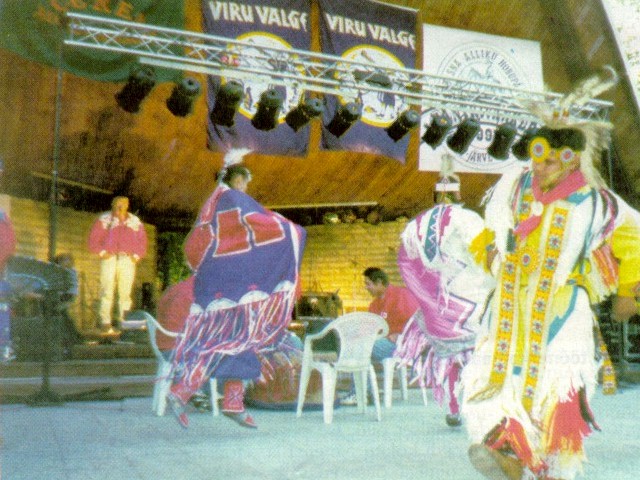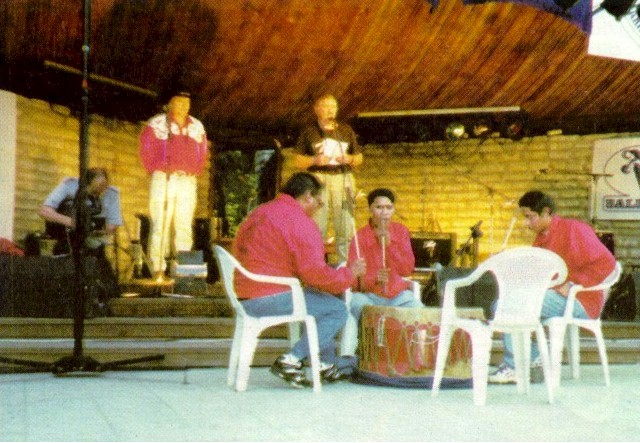
From Postimees EXTRA (July 5, 1997)
The people remain expectantly silent as the performers come on stage. The audience of Harku Lake country music festival has already seen a thing or two, has already tasted something and is a little sleepy in the hot sun. But when the drum starts beating and the guttural voices start howling, the people are struck by a sudden excitement. The children first, the older people on their heels, people rush as close to the Cree Indian folk music group Iron Swing Dancers as possible.
The folk costumes of the maidens (more precisely girls, two of whom have even been elected princesses of their tribe/band) are very gaudy. The only primary colour my eye could not catch in their dresses was brown. The costumes were decorated with very many fringes and jingles. During one dance, a feather fan appears in the hands of one dancer. There are not many feathers to frame the dark hair, but their beauty was striking even without these.

The three young gentlemen who are howling in the background in a mighty manner and beating a large drum in an even mightier manner, in contrast, look like the former EÕM – blue jeans and red jackets. This reminds one of the gatherings and the amateur art contests. However, the features of the performers are too peculiar to be familiar. And so is the music, at least in the beginning.

The readers may see what the costumes looked like from the photographs but unfortunately I am unable to transmit the music in the newspaper – which is a pity, since it would be impossible to explain that kind of music to someone who has not heard it by means of words. For some curious reason, Estonian is very poor in Cree folk culture terms.
We all have read books and seen films (such as the series Shehaweh that was recently shown on the national television) about the hard life and the tragic fate of the Indians and sympathized to them in our childhood or even later.
The group of mostly young Crees from Sturgeon Lake in Canada has crossed the ocean on the invitation of the society for culture exchange between Native Americans and Estonians Thunderbird, which is headed by Omar Volmer. According to him, the negotiations with the Cree were led by Kärt Summatavet of the Estonian Academy of Arts and Riina Laur of the College of Light Industry. The group was accompanied by Wesley Stevenson of Saskatchewan Indian Federated College. Naturally, he did neither dance nor howl but just shared the performers’ feelings.
Cree Indians have their own view of their history. The tribe has been peaceful and tried to keep good relations with both the white and their neighbouring tribes and therefore they were wealthy and managed to avoid wars. Only when the palefaces deprived the tribe of the last remains of their independence was there an abortive uprising. Today there are over a hundred thousand Cree, one distinguishes between Forest and Prairie Cree, which are in turn divided into subsidiary tribes.
Intercourse with the white gave the Cree firearms but also a new fashion of dress and the folk costumes of the Cree have been made of cloth instead of leather for centuries by now. The fact that many dances of neighbouring tribes have reached the banks of Sturgeon Lake is also grounded by lively culture exchange.
“The dances of all North American Indians are quite similar,” explains Terry Daniels, a majestic middle-aged Indian gentleman wearing a cowboy hat instead of feathers who acted as the host of the show.
Steps of the dances have been borrowed from neighbouring tribes but also from Europeans.
The first dance is a dance of good mood, the last one a social dance. In between, there are several similar dances with quite similar background (drum and howling still) so that Omar Volmer who is acting as the interpreter has to consult on nuances with Daniels. Grass dance (used on healing ceremonies), for example, is not borrowed but received as a gift from the Omaha who live quite far in the South.
Harku Lake was the starting point to discovering Estonia for the Iron Swing Dancers. During one week, the Country Carriage festival carried a company which, although international, had common interests to Toila, Viljandi, Kuressaare, Viljandi, Põlva and ultimately to Roosna-Alliku. The initial impressions of the guests were good. Or at least so they let the interviewer know, although one could notice that the Native Americans were quite restrained both on the stage and off the stage.
The Indians accompany the local well-known country music band Kukerpillid. The leader of the band Toomas Kõrvits claims that they are not just using the exotic guests. Since The Kukerpillid just came from a concert tour in the United States, the culture exchange should be balanced. Kõrvits uses one short sentence to justify the selection of the Cree group as their warm-up band: “They are so nice.”
Anti Riisalu, a member of board of the fuel company AA Trading is a great friend of country music. Harku Lake country music festival was revived and attracted considerable numbers of audience much by his efforts.
“We did not plan any profit but we would like to get even,” he stated. The main organisers of the festival and the following Country Carriage tour were Emil Oja and BG Muusik Ltd.
Bringing the performers of authentic Native American folk culture cost the organisers many times more than the most expensive Estonian bands. But there is still one question: does Native American folk music qualify as country?
“If we take the term country music literally, it qualifies very well since Indians live in the country,” believes Riisalu.
* * *
Jingle Dress Dance is followed by a sneak-up dance and a hopping dance (?). Cameras are flashing and the people are listening intently. A four-year-old spectator is beating time on the stage floor with a rock, as a two-year-old is trying to crawl under the feet of the dancers.
The dancers ask whether there are any people brave enough to join the last, a social round dance. And the space in front of the stage is soon full of such brave people.
The ending of the show is sad. A man appears on the stage and says: “And now let us thank the guests from the land of Canada very, very much...” upon which the usual country music well suited for dancing continues.
There are many kinds of country music.